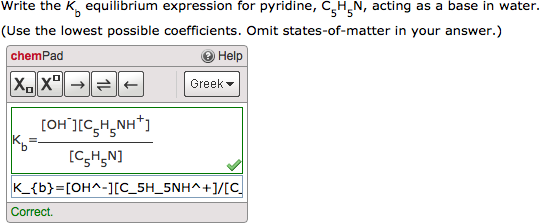When you create chemPad questions that are answered with a kinetic or equilibrium expression, your students can change the order of compounds (with their exponents) relative only to their position in a fraction.
For example,  is considered equivalent to
is considered equivalent to  . Your students can also enter multiplication or solvate dot notation if needed.
. Your students can also enter multiplication or solvate dot notation if needed.
Note
- When your students enter subscripted or superscripted letters in chemPad, they must
enclose
the subscript or superscript in braces {} to receive credit. For example, to enter
Kb, your students must type
K_{b}. - Your students must specify solvate dots in their responses. However, if they omit multiplication dots, their responses will still be scored correctly.
Example chemPad Question (Equilibrium Expression)
The following table summarizes an actual question.
|
QID |
|
|---|---|
|
Name |
|
|
Mode |
|
|
Question |
|
|
Answer |
|
|
Display to Students |

|